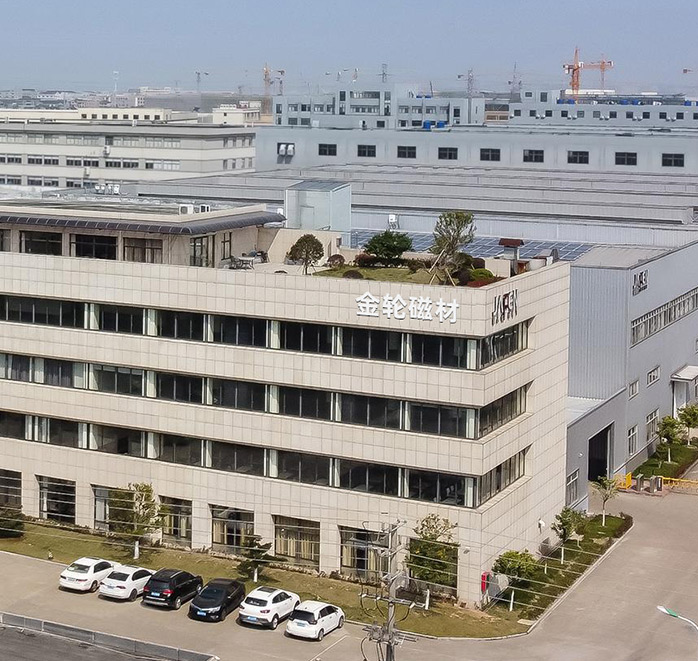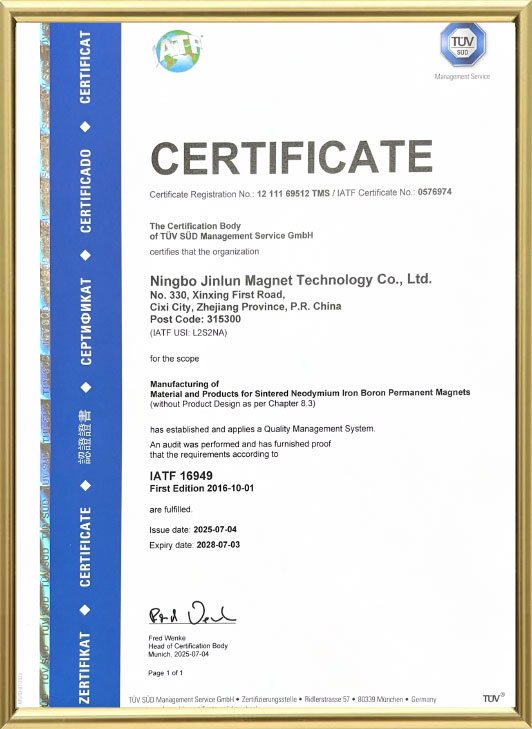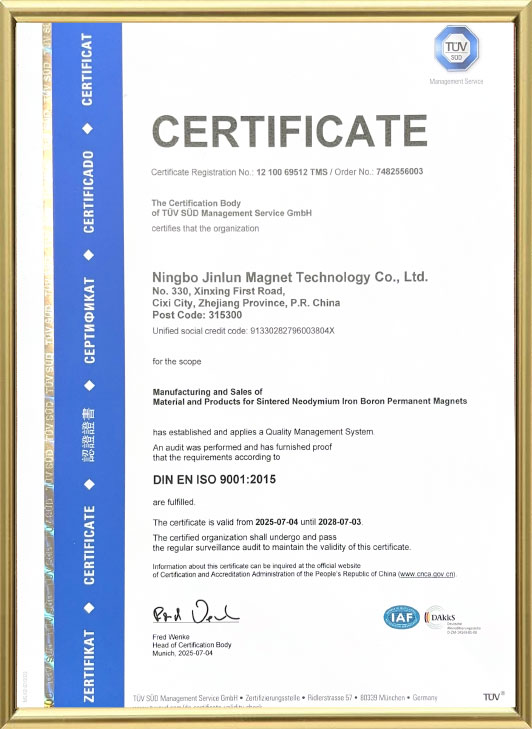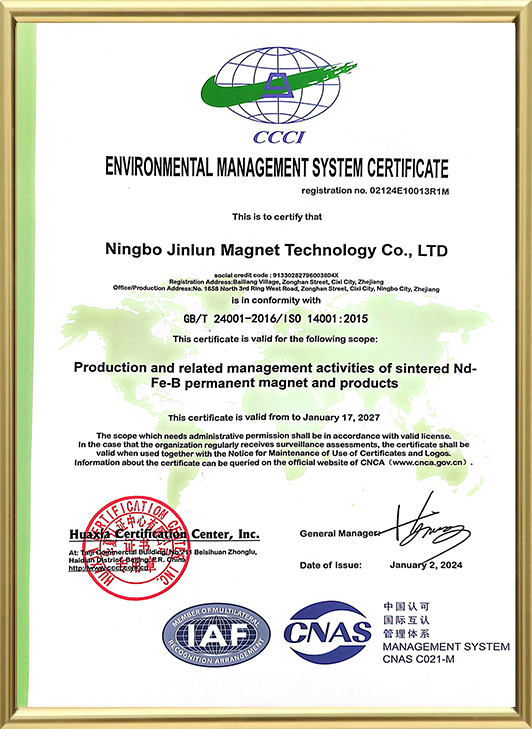Arc Permanent Magnet: A Complete Analysis of Its Characteristics, Applications, and Manufacturing Process
What is an Arc Permanent Magnet?
Arc permanent magnets, or arc-shaped permanent magnets, appear to have a curved shape and can be considered a portion of a circular magnet. Their curvature can be flexibly adjusted to meet specific application requirements. This unique shape gives them exceptional magnetic field distribution characteristics, offering irreplaceable advantages in a wide range of applications. In motor applications, their curved structure better aligns with the motor's rotating components, optimizing magnetic field distribution and improving efficiency and performance.
Material Classification
Ferrite arc magnets: Made from ferrite materials, they offer advantages such as relatively low cost and excellent chemical stability. Their primary components include iron oxide and other additives, which work together to impart a certain degree of magnetic properties. Ferrite arc magnets are widely used in cost-sensitive applications such as general loudspeakers and small motors, where magnetic requirements are less stringent and cost-effective. In standard loudspeakers, ferrite arc magnets generate a suitable magnetic field that interacts with the voice coil, converting electrical signals into acoustic signals.
Neodymium Iron Boron (NdFeB) arc magnets: These are rare earth permanent magnets with extremely high magnetic energy product, coercive force, and remanence, capable of generating very strong magnetic fields. Their primary components are neodymium (Nd), iron (Fe), and boron (B). To achieve varying properties, rare earth metals such as dysprosium (Dy) and praseodymium (Pr) are added, and iron can be partially replaced with metals such as cobalt (Co) and aluminum (Al). NdFeB arc magnets are commonly used in high-end applications requiring extremely high magnetic properties, such as drive motors for new energy vehicles, high-performance industrial motors, and magnetic resonance imaging equipment. In new energy vehicle drive motors, the strong magnetic properties of NdFeB arc magnets ensure high torque output, improving vehicle performance and range.
Alnico arc magnets: Made from an alloy of aluminum, nickel, and cobalt, they exhibit excellent temperature stability, maintaining relatively stable magnetic properties even in high-temperature environments. Alnico arc magnets are suitable for applications requiring high temperature stability, such as sensors in the aerospace industry and magnetic components in precision instruments. In the aerospace field, due to large fluctuations in ambient temperature, AlNiCo arc magnets ensure stable operation of sensors and other devices under varying temperature conditions, guaranteeing system reliability.
Arc Permanent Magnet Applications
Motors
Arc Permanent Magnets play a key role in various motors. In permanent magnet DC motors, they serve as the core component for generating a constant magnetic potential source, offering significant advantages over electromagnetic motors that rely on excitation coils to generate their magnetic potential source. Permanent magnet motors have a simpler structure, eliminating complex excitation systems and making maintenance easier. Furthermore, their lighter weight and smaller size significantly save space and material costs. They also offer high operational reliability, reducing the risk of downtime due to excitation system failures. Furthermore, permanent magnet motors have lower copper and energy consumption, meeting modern society's pursuit of energy conservation and environmental protection. For example, in electric vehicle drive motors, the use of high-performance NdFeB arc magnets can significantly improve motor efficiency and power density, thereby enhancing the vehicle's power performance and range.
Electronic Devices
Arc Permanent Magnets are also widely used in consumer electronics. In vibration motors in devices like mobile phones and tablets, arc magnets work with coils to generate vibrations, providing tactile feedback to users. In hard drives, arc magnets control the movement of the magnetic head, enabling fast data reading and writing. As electronic products continue to become smaller and lighter, higher demands are placed on the performance and dimensional accuracy of arc magnets, requiring them to provide a stable and powerful magnetic field within a limited space.
Medical Devices
Arc Permanent Magnets play an irreplaceable role in medical equipment. Magnetic resonance imaging (MRI) equipment requires a strong and uniform magnetic field to achieve clear images of internal tissues and organs. Neodymium iron boron arc magnets, with their high magnetic energy product and excellent magnetic field uniformity, are an ideal choice for MRI equipment, helping doctors accurately diagnose conditions. Arc magnets are also used in sensors in some small medical devices, such as blood glucose meters, to detect and control relevant physical quantities, ensuring accurate measurements. Other Fields
In the aerospace sector, Arc Permanent Magnet is used to manufacture various sensors and actuators, such as attitude sensors and solenoid valves, to help aircraft achieve precise attitude control and system operation. In wind power generation, arc magnets are used in the rotors of wind turbines, efficiently converting wind energy into electricity. Their performance directly impacts the efficiency and stability of wind power generation. In industrial automation production lines, arc magnets are used to manufacture magnetic separators and material conveying devices, enabling the separation and precise conveying of metal materials.
Arc Permanent Magnet Manufacturing Process
Ferrite Arc Magnet Manufacturing Process
Wet Pressing Anisotropic Process: First, the raw materials undergo a pre-sintering process to achieve certain physical properties. Next, coarse grinding (primary ball milling) refines the raw material particles to an appropriate particle size. Then, batching is performed to uniformly mix the various raw materials according to a precise formula ratio. A secondary ball milling process further refines the particles and achieves a more uniform composition. During the forming stage, a directional magnetic field is applied to align the ferrite particles in the mold. Wet pressing is then performed to produce anisotropic green bodies. Finally, after sintering and processing, the resulting ferrite arc magnet is manufactured. Ferrite arc magnets manufactured using this process exhibit high magnetic properties in specific directions due to the oriented particle alignment.
Dry-pressed isotropic process: This process does not apply an oriented magnetic field during the forming process. The raw materials are pre-sintered, roughly ground, and blended before being dry-pressed. Because there is no oriented magnetic field, the resulting magnets exhibit relatively uniform magnetic properties in all directions, but the overall magnetic properties are lower than those produced using the wet-pressed anisotropic process. The dry-pressed isotropic process is relatively simple and low-cost, making it suitable for cost-sensitive applications with low magnetic performance requirements.
Dry-pressed anisotropic process: Similar to the wet-pressed anisotropic process, the dry-pressed anisotropic process also requires an oriented magnetic field during the forming stage, but uses a dry-pressing method. After pre-sintering, roughly grinding, and blending, the raw materials are dry-pressed under an oriented magnetic field. Subsequent sintering and processing are also performed to complete the product. This process combines the advantages of dry pressing, such as high production efficiency, while also ensuring the product possesses certain anisotropic magnetic properties.
NdFeB Arc Magnet Manufacturing Process
Sintering Process: Neodymium, iron, and boron are mixed in specific proportions and smelted to form an alloy ingot. The ingot is crushed to produce smaller particles. Air jet milling then refines the particles to a desired particle size, forming a micron-sized powder. During the forming stage, the powder is placed in a mold and pressed under a magnetic field to align the powder particles, resulting in a green body with a specific shape and density. The green body undergoes sintering, which causes a solid-phase reaction between the particles, forming a dense microstructure and achieving high magnetic properties. The sintered product undergoes machining and surface treatment to meet the dimensional accuracy and surface quality requirements of different applications. NdFeB arc magnets manufactured using the sintering process offer high magnetic properties, meeting the demands of high-end applications. Bonding process: NdFeB magnetic powder and a binder (such as plastic or rubber) are first mixed in a specific proportion to form a composite material with excellent moldability. The composite material is then processed into the desired arc-shaped magnet shape through molding methods such as injection molding, extrusion, and pressing. NdFeB arc magnets produced using the bonding process offer advantages such as high dimensional accuracy, high production efficiency, and the ability to form complex shapes. However, due to the presence of the binder, their magnetic properties are somewhat lower than those produced using the sintering process. However, in applications where dimensional accuracy and molding processes are required, while magnetic properties are less demanding, bonded NdFeB arc magnets offer significant advantages.
Ningbo Jinlun Magnet Technology Co., Ltd., a professional magnet manufacturer, possesses extensive technical expertise and advanced manufacturing capabilities in the production of arc permanent magnets. The company boasts state-of-the-art permanent magnet production equipment, enabling efficient and precise production of various arc magnets. In terms of R&D, the company continuously invests in researching new materials and manufacturing processes to meet the growing market demand for high-performance arc magnets. For example, in the production of NdFeB arc magnets, the company has successfully improved the product's magnetic energy product and coercivity by optimizing sintering process parameters and raw material formulations, enabling its wider application in new energy vehicles and high-end industrial motors. The company also prioritizes product quality control, rigorously testing and monitoring every step of the production process, from raw material procurement to production. This ensures that every Arc Permanent Magnet leaving the factory has stable and reliable performance, providing customers with high-quality products and superior service.
 EN
EN English
English 中文简体
中文简体 русский
русский Deutsch
Deutsch 日本語
日本語 한국어
한국어




















